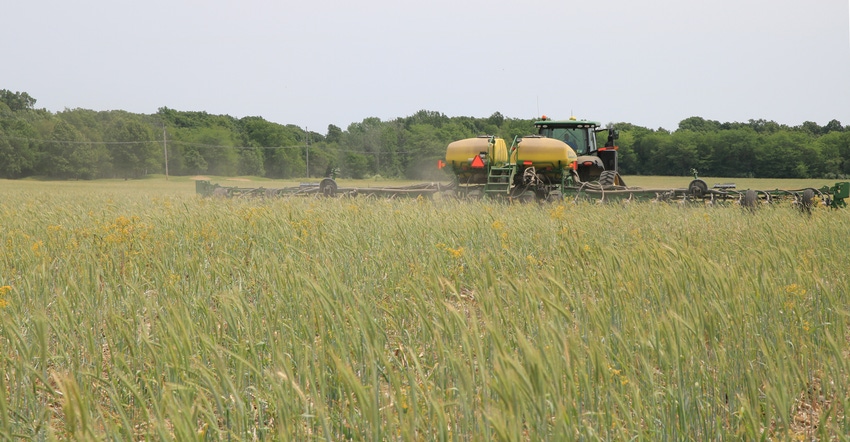
What has a farmer and ag professor learned about cover crops and weed control? Pete Fandel has used cover crops on all his fields at his Metamora, Ill., farm for eight years. He teaches ag — and cover crop use — at Illinois Central College. Here are five ways he’s learned to improve cover crop performance:
1. Use a high population. Cover crops play a pivotal role in weed control programs when you plant them at a high enough population, Fandel says. For cereal rye, Illinois’ most popular cover crop, plant at 55 pounds per acre or more to have a significant impact on weeds.
“The principle is that the more canopy you develop — with cover crops, corn or soybeans — the more sunlight you prevent from reaching the ground, which weeds need to grow,” Fandel says.
Establishing a healthy stand to crowd out weeds can be done either with a drill or through aerial application. He says as long as a farmer keeps an eye on the weather and has the seed flown on when there’s good soil moisture, an aerial-seeded stand can be just as thick as one that’s been drilled.
2. Pick the right species. Fandel says cover crops, even species that die off with a freeze, can drastically reduce or eliminate weeds that come up in the fall and overwinter.
Cereal rye is one of the most winter-hardy cover crops. Including it in a mix planted at or before harvest in preparation for planting soybeans the next year puts down a blanket of protection against both winter annual and early spring weeds.
Fandel likes mixing rapeseed with cereal rye because Illinois research shows it reduces sudden death syndrome in soybean fields. He also plants winter barley ahead of corn instead of cereal rye.
He views a slightly higher seed cost as worth it because winter barley doesn’t produce as much growth in the spring, making burndown and planting more manageable on half his acres. Cereal rye residue also releases a chemical that can slow corn growth, as well as any other grass plant, through what’s called an “allelopathic effect.”
“Cereal rye can have an allelopathic effect on corn, so I plant winter barley ahead of corn instead,” Fandel says. He notes barley still leaves behind a good amount of residue to shield soil from sunlight while corn grows a canopy.
3. Take a page from the organic playbook. Fandel looks at organic farmers who plant even higher rates of cereal rye ahead of soybeans than he does. They often plant directly into thick, recently crimped cereal rye as their main strategy for weed control in lieu of a chemical trait platform.
“A lot of organic farmers that use cereal rye crimp it once it reaches the flowering stage. But I typically want to get out as early as I can, so I try to do my burndown before it flowers,” Fandel says.
He says the tillage used by organic farmers often unearths large-seeded broadleaf seeds and creates an environment where broadleaf weeds can prosper, but a heavy mat from cover crops will counteract the effect and hold weeds back.
“You’re preventing them from even germinating in the first place, plus the allelopathic effect kills some of those young seedlings as they try to take off,” Fandel adds.
4. Know how tillage changes weed pressure. Tillage generally brings large-seeded broadleaf seeds, like those from giant ragweed, closer to the surface of the soil. This gives them a greater chance of germinating and competing with row crops. No-till generally gives an advantage to small-seeded broadleaf weeds such as marestail and waterhemp. Their seeds are smaller and tend to stick closer to the surface.
“Waterhemp tends to defy that trend just because they’re prolific seed producers. If you till one time really deep into the ground, that might help you. But when you till again, you’re dealing with millions of seeds — you’ll bring a lot of them back up to the surface,” Fandel says.
In-row cultivation, used by organic and non-GMO farmers to combat weed pressure before canopy closure, also has an effect on the weed composition of a field. He says there are weed species that germinate later in the year when temperatures are warmer. Cultivation could give them an advantage.
“If you row-cultivate late in the season, that may help with certain weeds,” Fandel says. “But it might make others more prolific.”
5. Boost microbes and close the canopy. The goal is to shade soil out, so one of the best strategies is to give corn and soybeans a strong start so they close canopies earlier. Fandel says there is promise in seed treatments that increase microbial activity, stimulate plant growth and increase nutrient efficiency. He’s beginning to look into them at Illinois Central College.
Fandel says from his own experience on his farm, years of using cover crops have resulted in a more active microbe population. Most microbes need living roots to survive, and by giving them roots year-round, he ensures residue from the prior crop is broken down more quickly. He says this effect takes a minimum of three years to show up in newly cover-cropped fields and helps him start planting earlier in the growing season, allowing him to achieve canopy closure earlier as well.
“All the responses you get from a crop because you have a healthy microbial community are going to help you in the long run too,” Fandel concludes.
About the Author(s)
You May Also Like




